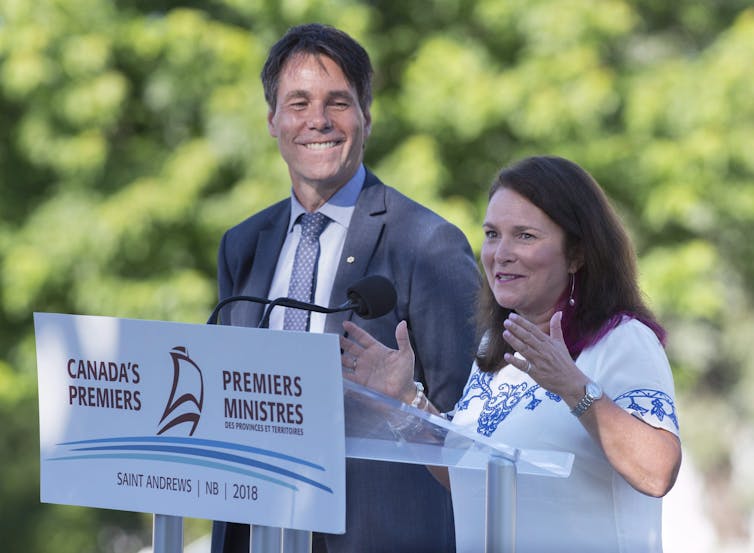Recently in Canada, there has been increasing public discussion of universal public drug insurance, or pharmacare.
The federal government’s Advisory Council on the Implementation of National Pharmacare is consulting with Canadians this summer on a program that would see prescription drugs covered through expanded publicly funded systems.
Premiers discussed pharmacare at their recent annual meeting, calling for a “voluntary” program designed and delivered by provinces, with federal funding and an ability for provinces to opt out.

Nonetheless, a number of myths have found their way into the public debate over the benefits and costs of pharmacare. Addressing these myths and misconceptions will help Canadians come to a reasoned opinion about whether the time is right to adopt a national pharmacare program.
Myth 1
Pharmacare will reduce choice of drugs to the detriment of patients.
All public and many private drug plans have a list of drugs eligible for coverage. Some argue that pharmacare will mean a reduced choice of drugs, and this will be harmful to patients.
First, not all pharmacare programs aim to cover the majority of prescriptions, at least not initially. There are proposals to start universal public coverage in Canada with a small list of essential medicines. Other prescriptions would continue to be paid for by existing public and private plans or directly by patients.
This was how Australia implemented universal pharmaceutical benefits in 1950, and they expanded to a comprehensive list of medicines within a few years.

Pharmacare could also be adopted with a list meant to cover most prescriptions. Even if this is the case, when it comes to drugs, more is not necessarily better. More new drugs, in particular, are not necessarily better: The level of effectiveness required for a new drug to receive marketing approval from Health Canada is actually fairly low.
In Canada today, public medicine lists are smaller than private because they are evidence-based. Drugs have to pass a high bar in an additional review process in order to be listed.
Read more: No, raising drug prices in Canada will not help the U.S.
This review focuses on how clinically effective a drug is, and also considers its value for money. This means public formularies do better at listing drugs that offer real benefits to patients, and they don’t waste resources on drugs that provide little benefit or have increased risks.
Finally, a private drug plan is not a guarantee of unlimited drug choice. Some private plans are already finding they need to raise premiums or co-payments, or reduce benefits, in response to increasing drug costs.
Myth 2
Canadian drug prices are not excessive; we already get a reasonable deal on pharmaceuticals.
It is sometimes argued that Canadian drug prices are not excessive and already offer value for money. After all, Canada has a Patented Medicines Prices Review Board (the PMPRB) with the explicit mandate to ensure that the prices of patented (brand-name or innovative) medicines are not excessive.
In 2016, the PMPRB began modernizing its guidelines for regulating drug prices. It acknowledged “the coupling of high Canadian patented drug prices and record low investment in R&D has many questioning the effectiveness of the PMPRB.” It noted that while Canada’s prices are at the median of the seven OECD countries the PMPRB uses as comparisons, this group of countries includes the highest drug prices in the world: Canada currently has the third-highest prices. Canada also spends more per capita on drugs than any OECD country other than the United States.
When comparing drug prices internationally, we should understand that the PMPRB uses “list” prices, similar to the “sticker” prices on new cars. Like new cars, the price of drugs is negotiated between sellers and purchasers and is not transparent.
Drug manufacturers offer purchasers confidential discounts in exchange for listing their drugs. Larger purchasers (such as governments purchasing for an entire country) can negotiate better prices.
Confidential price negotiations likely widen the gap between drug prices in Canada and countries like the United Kingdom and Australia, because smaller provincial drug plans have less negotiating power and the discounts they get only apply to people who are covered by public plans.
Myth 3
Pharmacare will result in less pharmaceutical industry investment (particularly in research and development) in Canada.
Some argue since pharmacare would result in more regulation and lower drug prices, it would cause the pharmaceutical industry to decrease investment. They argue this would hurt the Canadian economy and patients’ access to innovative drugs.
The PMPRB points out that pharmaceutical R&D investment in Canada is already comparatively low (five per cent of sales versus 20 per cent in the U.K., which has much lower prices). It notes that R&D investment is driven by location of head offices, trial infrastructure and scientific clusters, not prices or insurance. This is supported by published academic research.
There is also a lack of evidence that pharmaceutical manufacturers choose not to market drugs in Canada because of regulation or pricing policies.
For example, researchers recently asked whether manufacturers forgo marketing applications for so-called orphan drugs for rare diseases in Canada. Many countries have orphan drug-specific regulatory incentives to recognize the challenges of bringing new drugs for very small populations to market, but Canada does not.
We might expect that this lack of incentives would make manufacturers reluctant to market these drugs in Canada, but the researchers have found this isn’t the case.
Read more: Pharmacare and the chaotic world of Canadian drug prices
As Canadians consider possibilities for pharmacare reform in the coming months, they should have access to the best available evidence about how it might work in our country.
Hopefully, a key outcome of the advisory council will be to make this evidence accessible to Canadians.

